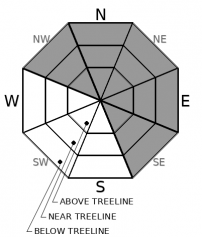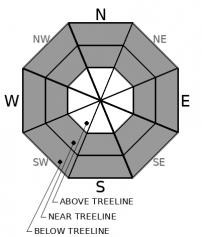| Tuesday | Tuesday Night | Wednesday | |
|---|---|---|---|
| Weather: | Cloudy. Snow showers. Snow levels below 7000 feet. Chance of precipitation is 100%. | Mostly cloudy. Chance of snow showers through the night. Snow levels below 7000 feet. Chance of precipitation is 30%. | Mostly cloudy then becoming partly cloudy. Snow levels below 7000 feet. Chance of precipitation is 10%. |
| Temperatures: | 15 to 20 deg. F. | 5 to 11 deg. F. | 23 to 28 deg. F. |
| Mid Slope Winds: | West 10 to 15 mph with gusts to 35 mph. | West 10 to 15 mph in the evening becoming light. Gusts up to 30 mph. | Light winds becoming northwest 10 to 15 mph in the afternoon. Gusts up to 30 mph. |
| Expected snowfall: | 80% probability of 3 to 7 inches. 20% probability of 7 to 10 inches. | SWE = 0.15-0.25 inch. | 30% probability up to 1 inch. 70% probability up to 2 inches. | SWE = less than 0.10 inch. | No accumulation. | SWE = none. |
| Tuesday | Tuesday Night | Wednesday | |
|---|---|---|---|
| Weather: | Cloudy. Snow showers. Snow levels below 7000 feet. Chance of precipitation is 100%. | Mostly cloudy. Chance of snow showers through the night. Snow levels below 7000 feet. Chance of precipitation is 30%. | Mostly cloudy then becoming partly cloudy. Snow levels below 7000 feet. Chance of precipitation is 10%. |
| Temperatures: | 10 to 15 deg. F. | 2 to 7 deg. F. | 18 to 24 deg. F. |
| Ridge Top Winds: | West 15 to 25 mph. Gusts up to 50 mph decreasing to 40 mph in the afternoon. | West 15 to 20 mph with gusts to 30 mph. | West 15 to 25 mph. Gusts up to 35 mph increasing to 45 mph in the afternoon. |
| Expected snowfall: | 80% probability of 3 to 7 inches. 20% probability of 7 to 11 inches. | SWE = 0.15-0.40 inch. | 30% probability up to 1 inch. 70% probability up to 2 inches. | SWE = less than 0.10 inch. | No accumulation. | SWE = none. |


























